Fountain pens can range in cost from under $5 to almost $100,000 and higher. How does one determine a reasonable price point? And what determines the differences between cheap and expensive fountain pens? We’ll cover that today by going through all the different fountain pen parts step-by-step and explaining how they differ based on cost.
Here, we’ll broadly categorize cheap fountain pens as those under $20 and expensive fountain pens as those over $200, but these are loose categorizations. And don’t overlook the mid-range pens that sit in the middle of these two prices.
Best Mid-Range Fountain Pens: $100-300
The Nib
Let’s start by distinguishing expensive fountain pen nibs from cheap ones. The nib is a vitally important part of any fountain pen. The nib conveys ink onto the paper through capillary action, by which a liquid is propelled through the interaction between surface tension and adhesion.
Overall, nib size has an obvious aesthetic impact, but flexibility also impacts your ability to have lines of varying widths. And nibs will also impact how favorably and cleanly the ink is spread onto the paper.
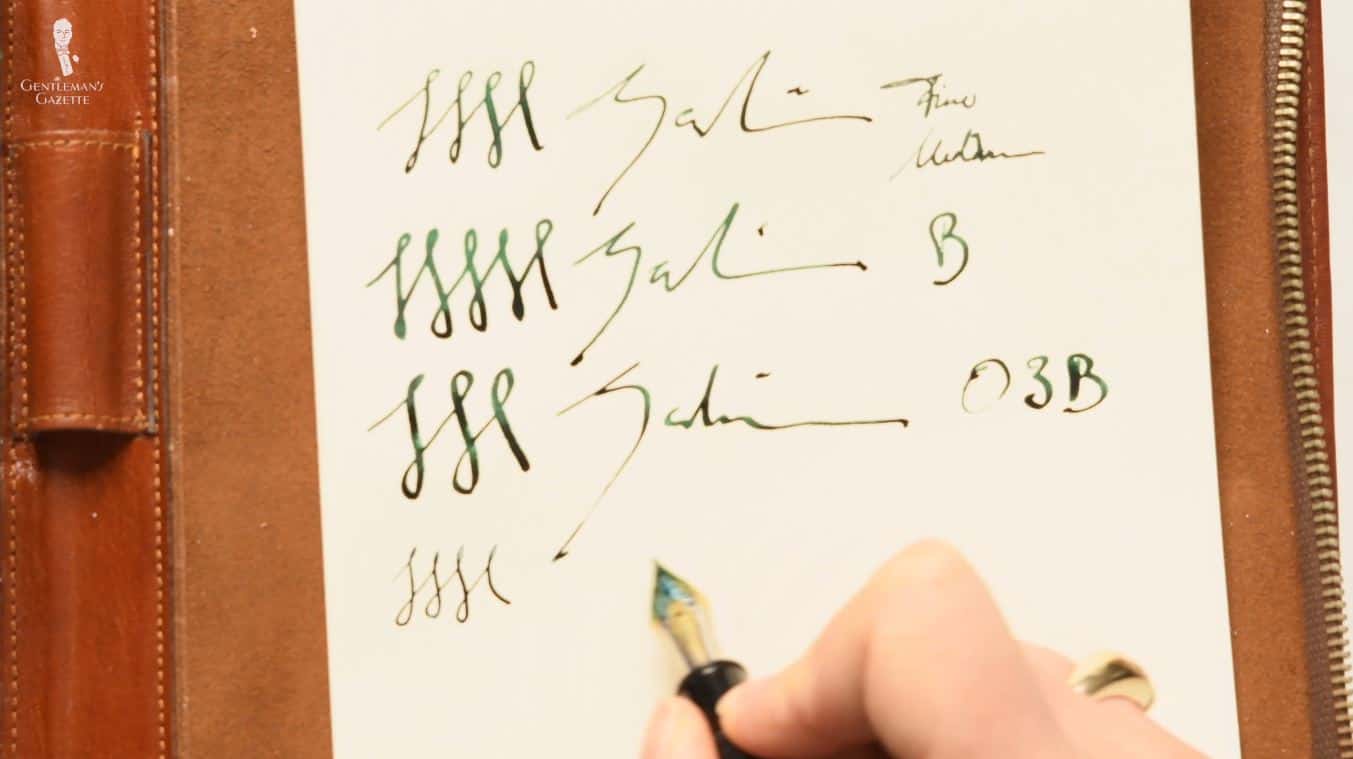
How does price affect this important functionality, then? Well, we’ll start by discussing cheap nibs, which are almost always made from stainless steel. Stainless steel is preferred by manufacturers because it’s relatively cheap and fairly durable. One aspect of a thorough nib comparison, though, is time between nib replacements, and, in the case of stainless steel nibs, their durability can actually be a problem.
The hardness of steel nibs means that they don’t flex easily or, in some cases, at all. And as we’ve already mentioned, flexibility is what allows for variable line width when you’re writing.
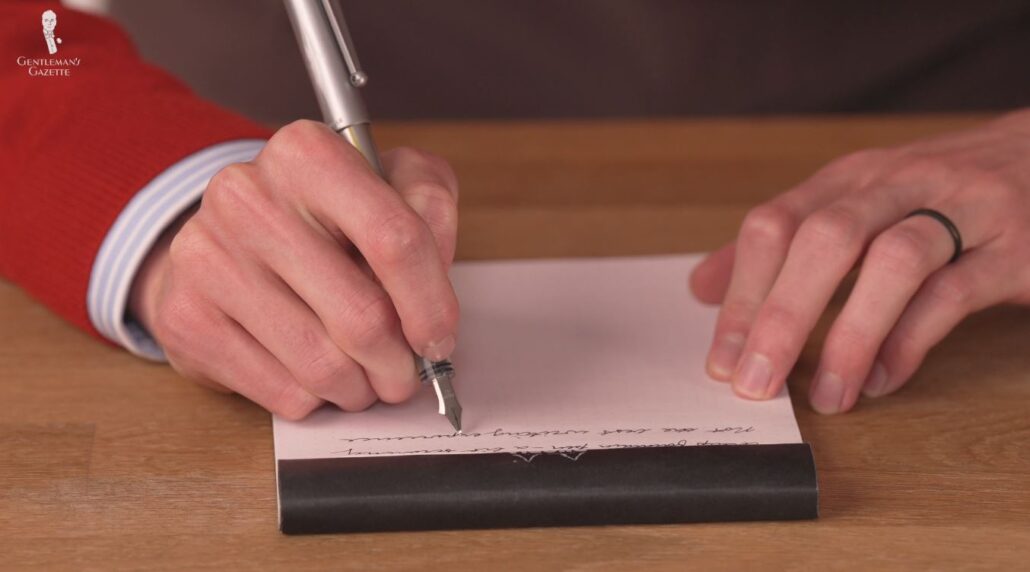
Tthe likelihood of skipping or spills and also requires the writer to push down on the paper with more force, making writing more uncomfortable over time. And really, pens that make writing less enjoyable seem pretty counterintuitive to us.
Cheap nibs are also more likely to gum up if not cleaned, although occasional cleaning is required of all fountain pens regardless of price, and not doing so is one of the most common beginner fountain pen mistakes.
Beginner Fountain Pen Mistakes
Another consideration is the issue of corrosion. Historically, stainless steel was very prone to corrosion as chemical scarring from corrosive inks would compromise the functionality of stainless steel nibs. In turn, this would adversely affect ink flow, consistency, and clarity of strokes. Modern stainless steel is more corrosion-resistant, but it still corrodes more quickly overall than the materials from which expensive nibs are made.
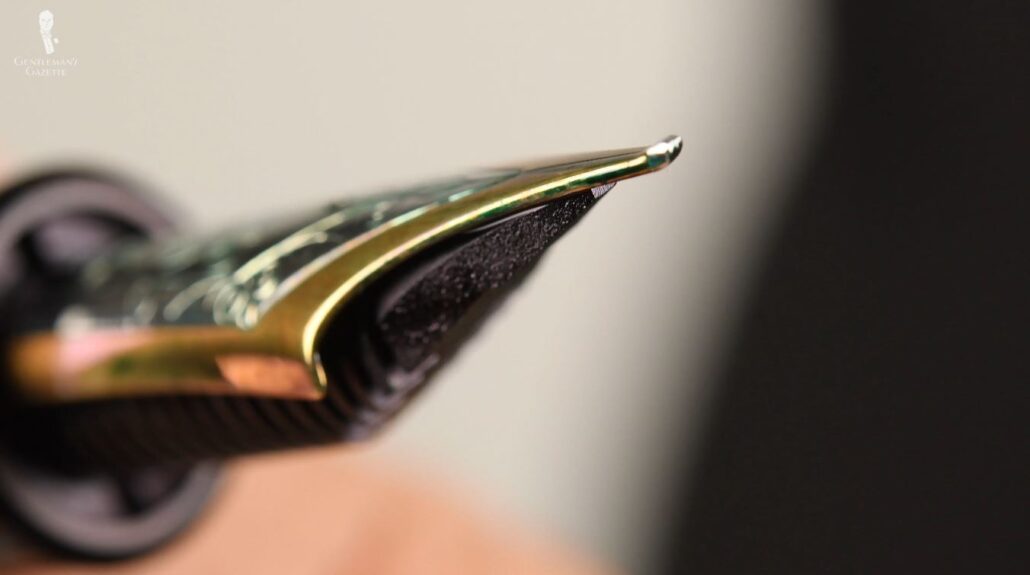
Speaking of which, expensive nibs are usually made from gold or titanium, with gold being a popular choice because it is both corrosion-resistant and has the flexibility to allow for variable line width, as well as springing back easily to the neutral position of the nib in between strokes. This softness will make the writing experience considerably more pleasant as you won’t have to push down very hard on the paper, and ink will flow out naturally and pleasingly.
Another hallmark of gold nibs or those made from similar materials is so-called “personalization.” This refers to the way that a gold nib will subtly bend and conform to your hand and writing style over time through settling and microscopic wear. This wearing-in will make the pen feel even more comfortable and natural, but will require a break-in period if you buy second-hand pens and might also make you think twice about sharing your pen with others.
Match your gold-nibbed fountain pen with our Fort Belvedere gold-toned accessories!
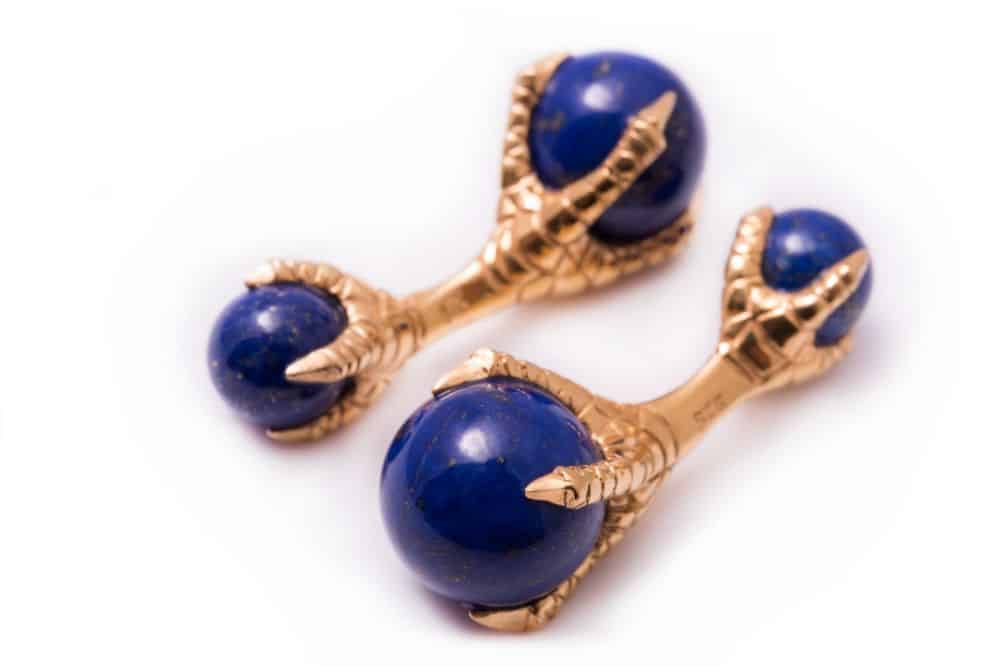
Eagle Claw Cufflinks with Lapis Lazuli Balls – 925 Sterling Silver Gold Plated
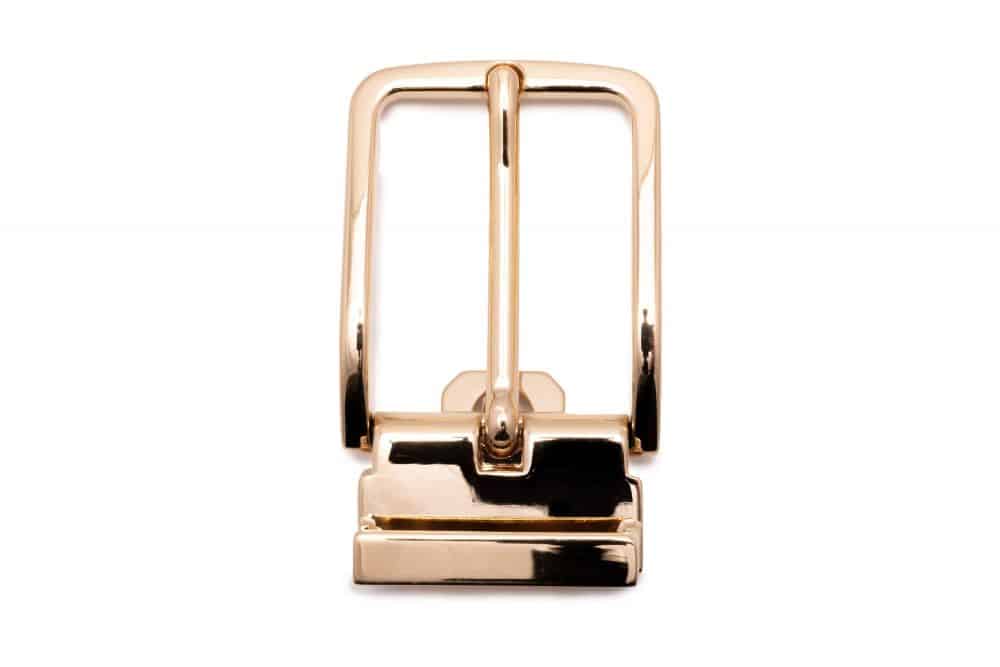
Neville Gold Solid Brass Belt Buckle Soft Corner Rectangle with Gold Plating Hypoallergenic Nickel Free

Collar Pin Safety Pin Gold
Ultimately, the nib has the most direct impact on the process of writing, and expensive nibs are able to improve the comfort, ease, and consistency of writing through their higher-quality materials and construction. Therefore, even if circumstances compel you to use a cheaper pen, finding a cheap pen with some more expensive nib qualities, like gold-plating, a quality tip, and decent flex, will ensure a writing experience that doesn’t leave your hand aching and your fingers feeling pinched and worn – if you’re using proper technique, that is.
How to Write with a Fountain Pen
The Feed
The feed connects the nib to the ink reservoir. This is what allows ink to flow freely through the nib when it’s in contact with paper but prevents ink from spilling out when you’re not using the pen. It does this thanks to a complex series of narrow channels. Basically, the ink flows into these channels through the capillary action that we mentioned previously.
When ink is flowing onto the paper, air from outside the pen is allowed to flow upward along the feed, bringing ink down from Ink storage. Cheap fountain pens will almost always have feeds made from plastic, which is preferred by manufacturers because it’s cheap to produce.
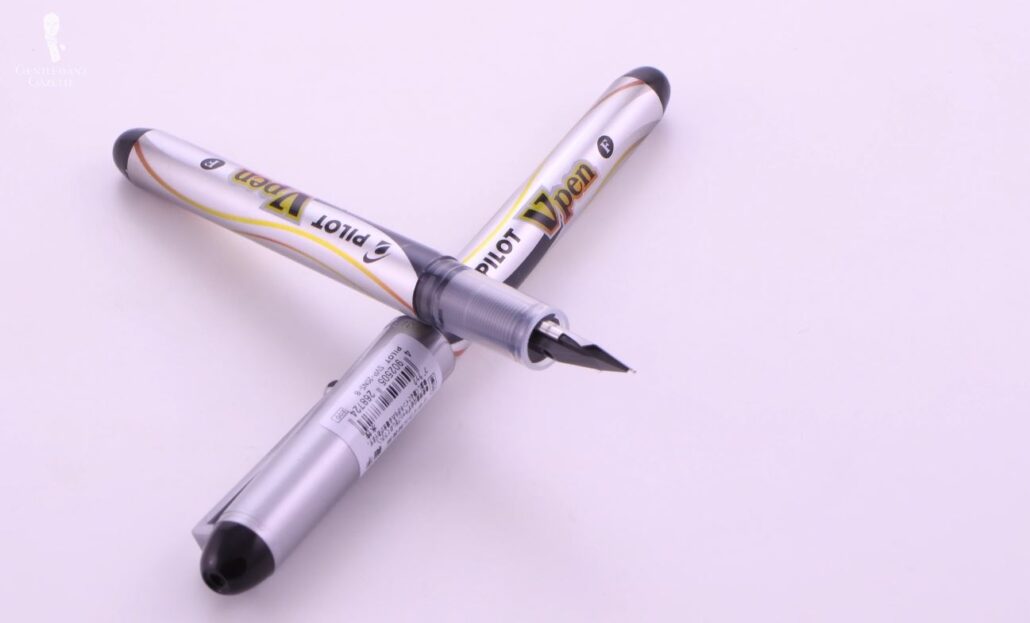
Practically speaking, plastic can actually function very well as a feed, provided that it is properly fitted into the pen. However, poorly-fitted plastic feeds can have disastrous consequences. Ink can dribble or overflow when writing or even spill out when the pen isn’t in use.
Airflow defects can also have exactly the opposite problem and prevent ink from coming out even when you want it to. As previously mentioned, though, these issues are usually caused by defects in manufacturing and not because of the qualities of plastic inherently as a feed material. Accordingly, plastic feeds are now increasingly common in middle and even some higher-tier fountain pens.
When it comes to expensive fountain pens, feeds should be guaranteed to ensure proper ink flow, no matter what material they’re made from. But, for an improved writing experience, the best pens will use Ebonite feeds, which is a hardened vulcanized rubber that is semi-porous. These microscopic air pockets help to equalize the flow of ink and air as they move respectively through the feed. This allows for more consistent ink propulsion and a smoother writing experience.
![Ebonite Ebonite feed [Image Credit: The Fountain Pen Network]](https://www.gentlemansgazette.com/wp-content/uploads/2022/10/ebonite-1030x577.jpg)
Ebonite is also easy to shape and mold so that it can be fitted more tightly into the body of the pen. Establishing a firm seal will help to improve ink transference and also lower the possibility of overflow or spills.
When it comes to feeds then, construction is ultimately more important than material. A well-made plastic feed will function well enough for most writers’ needs, but an Ebonite feed represents a noticeable step up in quality that will definitely improve your writing experience. So, not only will a cheap fountain pen not have an Ebonite feed, but it might also have a poorly-fitted plastic feed, which will turn even your best writing from tressy to messy.
The Body
The body of the pen is essentially just a container that holds all the components that actually make the pen function. Obviously, the body considerably impacts the appeal and aesthetics of the pen itself, but it also impacts the functionality of writing when it comes to the balance and weight of the pen.
The majority of cheap fountain pens are made from plastic because they’re easy to make and cheap to produce. Some cheap fountain pens can also be made from wood or metal, but to keep costs low, these will usually be low-quality varieties of each.
Stylistically, you can expect cheap fountain pens to either appear plain and boring because you can’t spend much on designers at this price point or garish and too busy because the design is meant to distract from the low quality of the materials used.
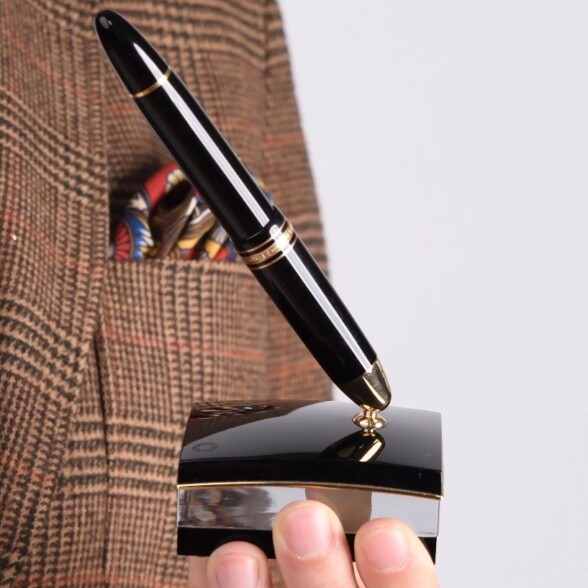
MORE THAN THE AESTHETIC APPEAL
When it comes to the balance and weight, the pen’s body also affects how well it writes.
At a cheap price point then, a heavily decorated or modish pen body is usually going to be concealing inferior interior parts. To further save costs on materials, regardless of what they actually are, a cheap fountain pen is almost always going to be very lightweight. This will make the pen feel awkward in the hand and lead to an unbalanced writing experience overall. This is because inadequate heft or poor balancing will confuse the way you grip the pen, leading your hand to become more uncomfortable over time as you apply pressure in incorrect ways.
This lack of balance is likely going to be the case whether or not you post the cap of the pen on its reverse, as the low-quality caps are also going to be made from these low-quality materials.
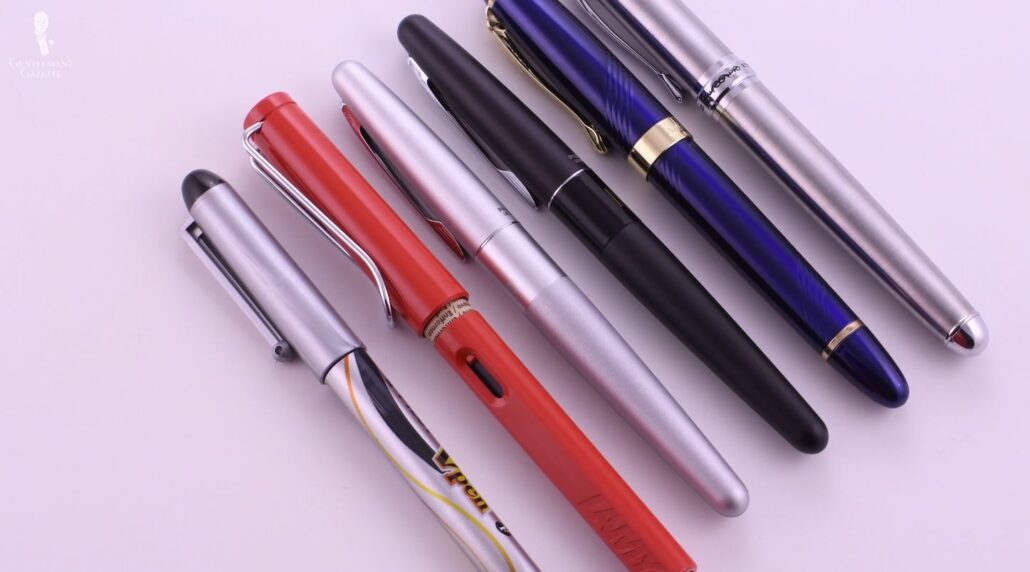
Speaking of the caps, these inexpensive pens are likely going to have clips that are either too rigid or too flexible – neither of which is helpful for storing your pen in your pocket. Meanwhile, expensive pens have usually been meticulously balanced to ensure comfortable writing over extended periods of time, and they’ll often come in variable hefts to suit your own particular writing style.
Expensive fountain pens are made from high-quality materials like resin, precious metals like gold or silver, or high-quality woods. Luxurious wood and precious metals probably don’t need much explaining, but I can hear you getting ready to ask, “Wait, isn’t resin just another type of plastic?” Well, yes, that’s correct. But, because of how resin is manufactured, it’s both much more durable and much more visually interesting.
So, if you think “quality plastic” is an oxymoron, just compare the body of these fountain pens, for example.
![Cheap Plastic Fountain Pen Pilot Varsity Disposable Fountain Pen made of cheap plastic [Image Credit: Office Depot]](https://www.gentlemansgazette.com/wp-content/uploads/2022/10/cheap-plastic-fountain-pen-1030x577.jpg)
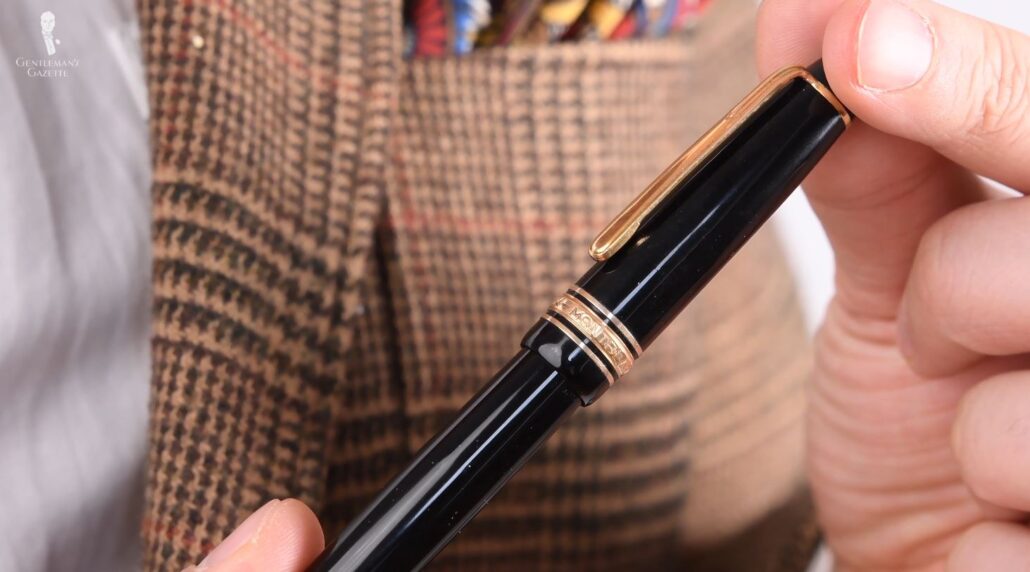
Indeed, many users actually prefer resin to metal or wood because it is slightly tacky, aiding grip; again, more durable and doesn’t feel cold to the touch. Obviously, this is a matter of preference, but, again, with expensive fountain pens, regardless of whatever they’re actually made of, you can rest assured that the quality of these materials is going to be higher overall.
At a higher price point, manufacturers are more likely to put a higher degree of thought into their designs, producing bodies and caps that are works of art in their own right. These can often be highly collectible and even make perfect gifts, especially if the body is adorned with precious metals or even gemstones.
One note here is that expensive fountain pens can quickly become especially expensive. So, if a pen is so expensive that you don’t feel comfortable carrying it or using it, you will again be left with a paperweight – albeit a more expensive one. So, be sure to balance any bling against the practicality of using your fountain pen on a day-to-day basis.
The Filling Mechanism
The filling mechanism is our next component. There are multiple ways to get ink into a pen, many of which come down to preference and personal taste. We cover them all in our general fountain pen guide, but there are definitely some clear dividing lines when it comes to cheap versus expensive fountain pens.
The Fountain Pen Guide
To reduce the number of moving parts, cheap fountain pens will almost always use cartridges. Poorly made ink cartridges often have poor ink flow and can leak, and even expensive cartridges can be difficult to change unless they’re empty, meaning it isn’t always easy to change the color of ink in your pen.
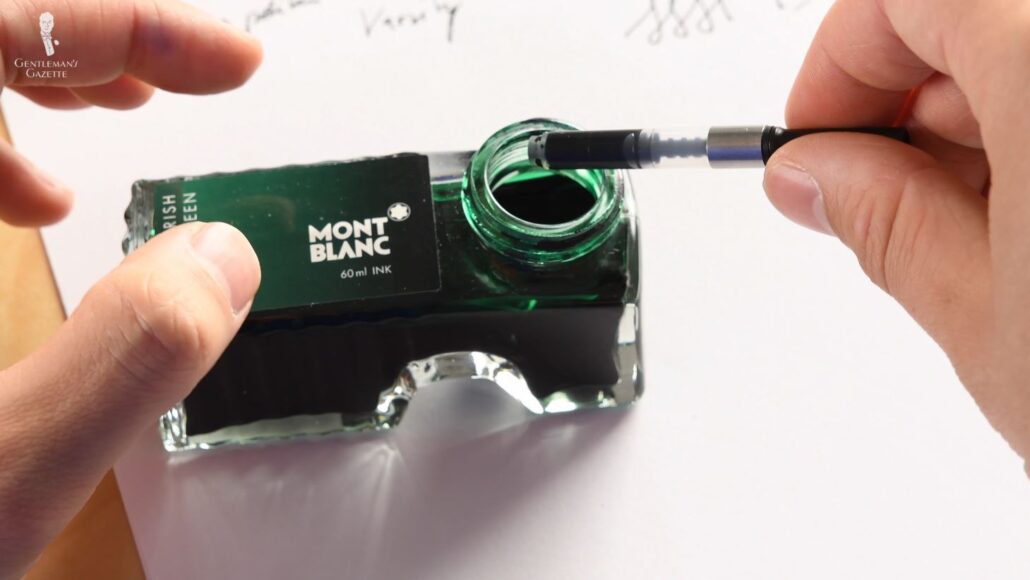
Of course, cartridges are also very convenient, but this convenience comes with both a monetary and an environmental cost. Cartridges produce a considerable amount of waste, and even recyclable cartridges still contribute to the use of energy through the recycling process.
Cartridges can also be expensive to buy, especially if your pen only takes proprietary cartridges as opposed to standardized models. And some cheap fountain pens aren’t even refillable at all, meaning that when the ink runs out, you just have to throw the entire pen away.
To think about it another way then, eventually, all of the money that you’ll throw away on “throwaway pens” could be put to better use by buying a more expensive pen with a refilling mechanism that works well.
![Disposable Pen Cheap disposable fountain pens typically do not allow ink refills [Image Credit: Office Supply]](https://www.gentlemansgazette.com/wp-content/uploads/2022/10/disposable-pen-1030x578.jpg)
As we mentioned already, expensive fountain pens, for the sake of convenience, can also take cartridges. These are less likely to leak or adversely affect ink flow, but they are still expensive.
As such, you’re also likely to see systems that draw ink through the nib into the reservoir. A twisting or pulling piston mechanism is most common today. But, in the early 20th century, you were more likely to see levers. And some pens also have convertible systems, meaning that they can draw ink or take cartridges. Systems like these are favored by many enthusiasts as they can flush the ink from the pen to change colors, and flushing can also make cleaning the pen easier.
Ultimately, then, the filling mechanism is most important as it pertains to your convenience. Investing in a more expensive system will usually make the process easier for you and will also spare you the unpleasant cleanup associated with cheap and leaky pens.
The Ink
Very briefly here, we’d like to conclude by highlighting the differences between cheap and expensive inks. In a nutshell, cheap inks are kept cheap by cutting corners. Pigmentation is low, leading to runny, bland, and semi-transparent colors; cheap ink is poorly manufactured, so it can be sticky or prone to smudge on the page; and cheap ink will dry hard inside the pen, potentially gumming up the works.
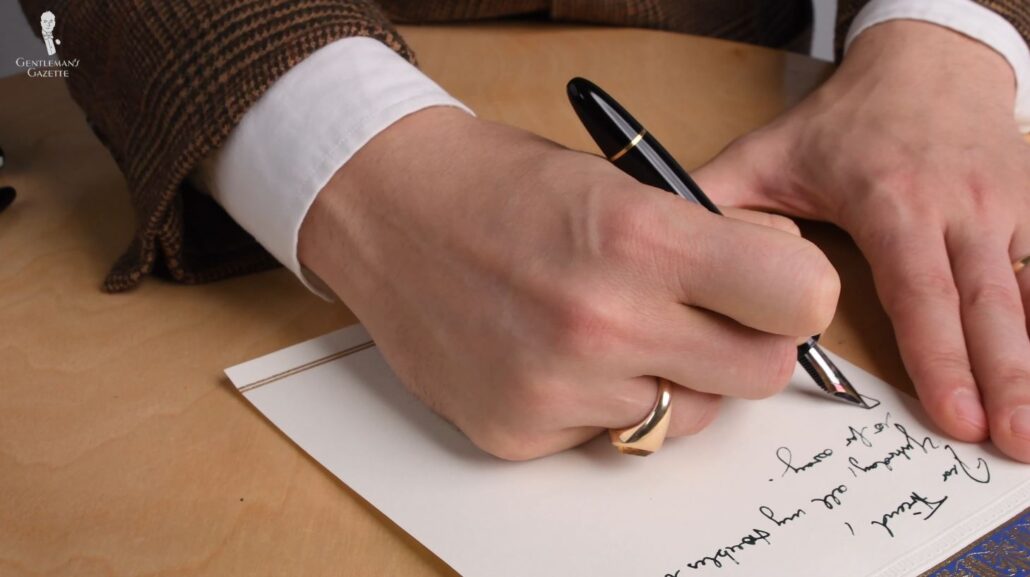
Expensive inks, on the other hand, will flow easily and lay neatly on the page; have good color fastness and endurance so they won’t fade with time, and come in various unique and memorable colors. Some of our favorite colors include rusty brown, sky blue, and dark green.
Not only will expensive inks be easier for you to write with, but they’ll also be easier for your correspondent to read and more visually-stimulating
Conclusion
Now that you’ve learned the differences between cheap and expensive fountain pens, you’ll have the knowledge to determine which price point is best for you. So, whether you’re interested in perusing our selection of budget fountain pens, looking into an expensive Montblanc, or, again, thinking that mid-range options might be best, we hope that this post proved to be a fountain of knowledge.
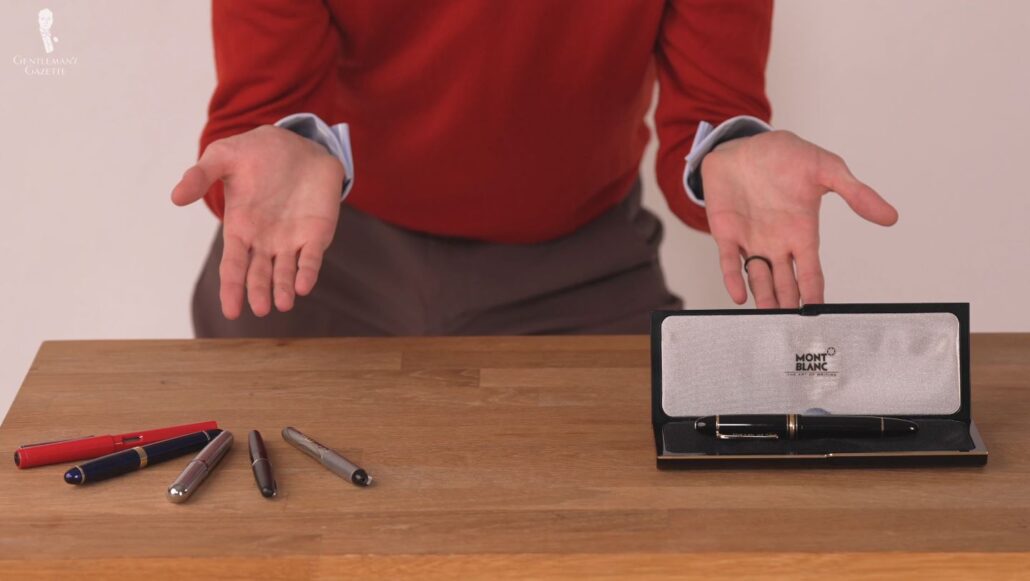
Are you a fan of fountain pens, too? What price point do you think is worth it? Let us know in the comments!
Outfit Rundown
Today, I’m wearing a casual outfit, good for sitting around the house and writing with some fountain pens. The central element is my blood orange V-neck sweater from Hawes & Curtis, which is worn over a blue and white striped shirt from Charles Tyrwhitt.
The shirt has French cuffs, but I’ve got them configured in a barrel-style today to fit better under the sleeves of my sweater, and, as such, I’m wearing simple black cufflinks that aren’t meant to be seen.
My trousers are in a plain brown shade that has a reddish undertone to go along with the orange in the sweater, and my shoes are moccasin-style loafers in brown suede from Velasca.
And rounding out today’s outfit are my two-toned, shadow-striped socks from Fort Belvedere in brown and light blue.
To go along with the casual nature of the outfit, I’ve also left product out of my hair and let my beard grow a bit. And, of course, for the socks I’m wearing today and a wide array of other classic men’s accessories, you can take a look at the Fort Belvedere shop.
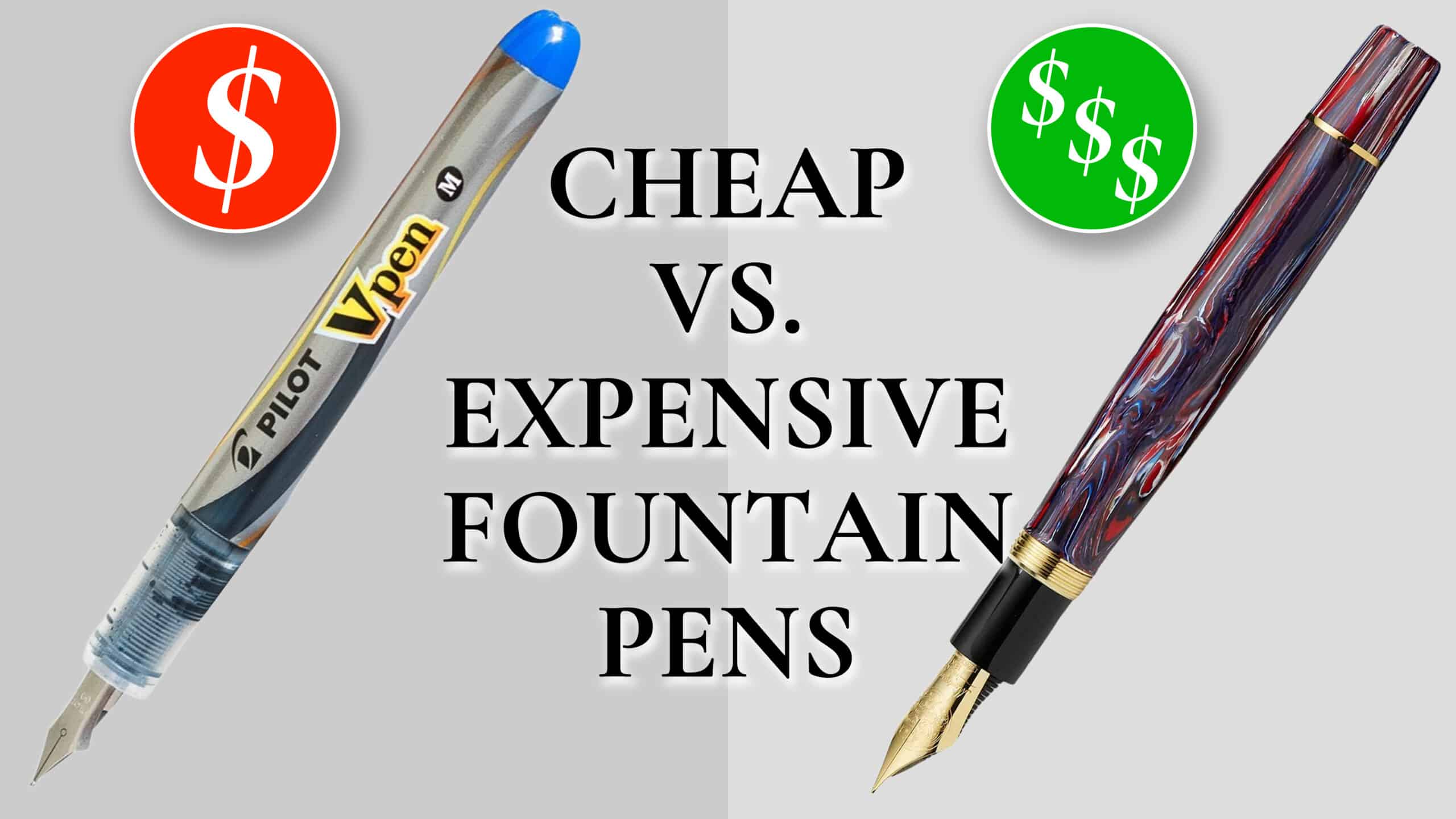

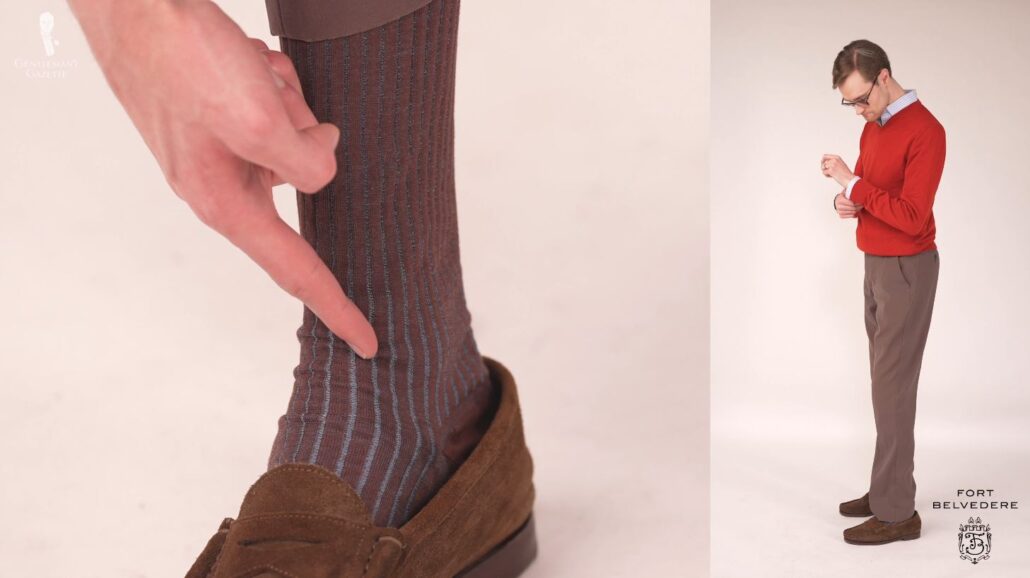
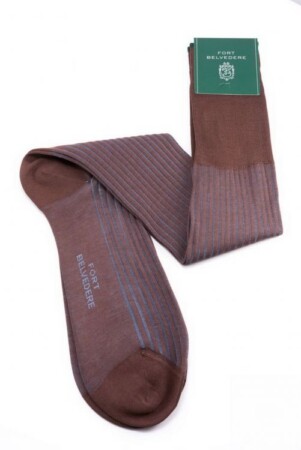
Paying a lot of money does not guarantee high quality where functionality is concerned. Visconti is famous for making beautiful pens that cost hundreds or thousands of dollars but its quality control is virtually non-existent. If you buy a new Visconti pen, the chance that it will write properly without adjustment or modification of the nib is no better than a toss-up. The cheapest Pilot fountain pen is a far more reliable writer. I name Visconti because it is a brand with which I have fairly extensive experience but there are other famous brands that do the same thing: they put pens on the market that never should have left the factory.
Featuring an ink by Monteverde as a “cheap ink” seemed to me quite unjust.
Thank you for this great article that really gets it to the point! Nothing compares to a gold nib when it comes to smooth writing. I own a collection of Montblancs, starting with an early 146 from the 1950s and currently ending with the brand new “JFK” special edition my wife gave me for a gift this year.
And well, are they worth it? When it comes to the price compared to the quality of writing: Probably not, even though they’re great writing instruments. But you can get the same or an even better writing experience for a smaller budget. It’s just that … nothing compares to that beautiful streamlined design of the 146s an 149s … In my personal opinion at least.
If you want a truly cheap start with a very low budget pen that even a Montblanc collector like me loves to use, try the Jinhao 159! These are made in China and truly cheap. But don’t let this raise your eybrows! Even though their steel nibs don’t compare to the gold ones used by Montblanc, they’re still very smooth writers with a perfect ink flow. The body is metal and very heavy, so you won’t have the issue with cheap lightweight plastic. And it comes with an ink converter, so you can switch between cartridges and bottled ink in a minute.
I use it to try different inks – and many times I find myself unwilling to put it down once I start writing, even though my farvorite Montblanc that cost about a hundred times as much lies just next to the sheet of paper I’m writing on …
By the way … I found the Jinhao 159 through an article on this very site here! Another big THANK YOU for this as well!
Thanks for your views on fountain pens, Kai! It seems as though you are also an avid fan of collecting and writing with fountain pens.
When you get around to doing a piece on ink, make sure you include paper. A quality pen and quality ink will not do well on cheap paper.
An excellent point Robert – something good to keep in mind
Preston, I’m afraid I’m going to have to take you to task for your (photographic) identification of the Lamy Safari pen as “cheap.” I have an aluminum-bodied Lamy that I’ve traveled the world with – I’ve jotted down notes with it from Paris to Chongqing to Mumbai to the big island of Hawaii. No, it is not the equivalent of my Mont Blanc Meisterstuck, but it has never let me down in places I wouldn’t consider taking a more valuable pen. It’s the perfect outdoors/traveling pen (I’ve always thought Hemingway would approve of it). And I’ve always felt that the Lamy’s pocket clip is not only well-made and functional, but minimalist and stylish in a bauhaus form-follows-function way, Inexpensive? Yes. Cheap? Not at all; an excellent value for the money,
Yep. I’d like to see an expanded video on the topic.
If you do a presentation on inks, do it in relationship to papers. I have found that an ink can write well with one paper but not another.